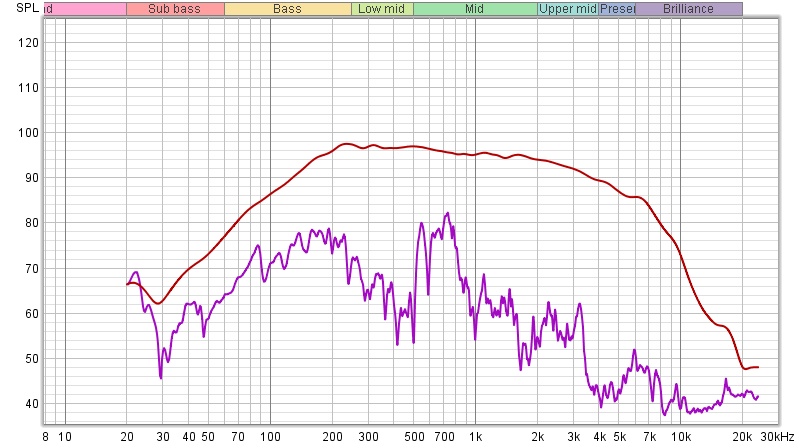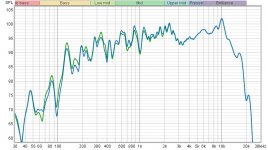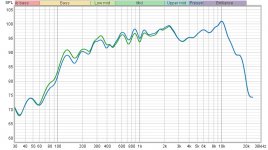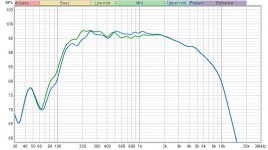Room acoustics, with and without the blankets, are what I was measuring in the first graph. In other words, what the entire speaker(resonances and all) is putting out into the room and picked up at the listening seat, which is what you will actually be hearing at the listening seat.
The next test will be with my "non resonant" cabinets measured exactly the same way as the Dunlavy's. If I'm correct, with or without the blankets should make very little difference on the fr at the listening seat. The two traces should be almost identical
The next test will be with my "non resonant" cabinets measured exactly the same way as the Dunlavy's. If I'm correct, with or without the blankets should make very little difference on the fr at the listening seat. The two traces should be almost identical
Last edited:
The size and shape of the box are now different with all those blankets on it. Could that account for the change? You know, diffraction, baffle step and so on.
Tell us again please what each trace here represents. I'm curious because of the activity around 700 Hz both here and on your front facing measurements.

Pano
The top trace is the speaker on axis at 12" mic distance
The bottom trace is the side panel center axis mic measurement(All else being equal) at 12", using the null technique.
These are nearfield measurements, and the problem with nearfield measurements, is that they don't represent the gestalt of what the loudspeaker as a whole is putting out into a room, which is extremely complex.
By measuring at the listening seat, with and without the blankets, and then comparing those measurements to the nearfield measurements, you can see how those nearfield panel measurements play out in the grand scheme of things.
Like I said previously, if the test on my non resonant speaker shows no difference with and without the blankets, we will know that it is the actual panel causing the room measurement differences on the Dunlavy's.
If the blankets on my non-resonant cabinets show the same results as the dunlavy's, then we will know that the blankets are the actual cause of the room measurement fr change.
I'll do the measurements today.
The top trace is the speaker on axis at 12" mic distance
The bottom trace is the side panel center axis mic measurement(All else being equal) at 12", using the null technique.
These are nearfield measurements, and the problem with nearfield measurements, is that they don't represent the gestalt of what the loudspeaker as a whole is putting out into a room, which is extremely complex.
By measuring at the listening seat, with and without the blankets, and then comparing those measurements to the nearfield measurements, you can see how those nearfield panel measurements play out in the grand scheme of things.
Like I said previously, if the test on my non resonant speaker shows no difference with and without the blankets, we will know that it is the actual panel causing the room measurement differences on the Dunlavy's.
If the blankets on my non-resonant cabinets show the same results as the dunlavy's, then we will know that the blankets are the actual cause of the room measurement fr change.
I'll do the measurements today.
Last edited:
The next graph is the same as above, but with psychoacoustic smoothing..
This graph is interesting. Your Dunlavy with heavy blankets is showing about a 2 dB greater output from 100 to 400 Hz... more or less, except for a few spots where the output with/without blankets is the same such as at 250 Hz and between 400 and 500 Hz.
Where there is no structural resonance, ordinary sound transmission through the cabinet walls will take place. The transmission loss through plywood and MDF is ~ 15 dB at these low frequencies. The sound transmitting through the cabinet will be out of phase with the main driver radiation.
The cabinet will behave very much like an open baffle speaker, one where the back wave is 15 dB lower than the front wave. In this case, we would expect cancellation of about -1.7 dB.
I don't know if this is what is going on with your Dunlavy's, but it is one plausible explanation. What you are seeing at 250 and 400-500 could be structural resonance perhaps?
Very interesting... and very timely. I am just starting a new construction now, and your work (along with Augerpro) has informed my bracing/damping strategy.
hifijim
I do need to do the comparison with my diy speakers today, to validate(or invalidate🙂) the current loudspeaker/room/mic interface measurements.
I do need to do the comparison with my diy speakers today, to validate(or invalidate🙂) the current loudspeaker/room/mic interface measurements.
Like the dunlavy's, 95db/2meters, with and without the blankets. There are some distinct similarities between the two speakers, which implies that the blankets are responsible for most of the fr differences. Not all, I'm sure, but most🙁
1 and 2 - 1/12th octave smoothing
3 and 4 - Psychoacoustic smoothing
The mtm arrangement on the dunlavy's is canceling out some floor and ceiling reflections, which accounts for the smoother in room response at two meters. They also have a 1st order passive filter applied at 3.5khz.
Dunlavy- red with blanket, green without
DIY - green with blanket, blue without
How on earth can the thick blankets be causing the bass to increase in the farfield measurements? That's what threw me for a loop on the dunlavy's. That result is totally counterintuitive. If anything, you would expect the blankets to absorb some of the bass.
1 and 2 - 1/12th octave smoothing
3 and 4 - Psychoacoustic smoothing
The mtm arrangement on the dunlavy's is canceling out some floor and ceiling reflections, which accounts for the smoother in room response at two meters. They also have a 1st order passive filter applied at 3.5khz.
Dunlavy- red with blanket, green without
DIY - green with blanket, blue without
How on earth can the thick blankets be causing the bass to increase in the farfield measurements? That's what threw me for a loop on the dunlavy's. That result is totally counterintuitive. If anything, you would expect the blankets to absorb some of the bass.
Attachments
Last edited:
This goes to show the incredible complexity of the loudspeaker/room/listener interface. Nothing can be taken for granted.
Could be as Jim mentions, baffle radiation canceling driver output. Or maybe the blankets make a bigger baffle, so that baffle step moves down.
Comparing the midrange change could be useful here.
Comparing the midrange change could be useful here.
Bass can't reflect off blankets as they would off a solid object like a wider baffle. Baffles by nature, are solid objects that help keep the front wave from interfering with the back wave(Or lowering or raising the step). Blankets on the other hand are 100% permeable and absorptive. All they're doing in this case is helping to absorb and convert sound energy to heat.
Last edited:
Could be as Jim mentions, baffle radiation canceling driver output. Or maybe the blankets make a bigger baffle, so that baffle step moves down.
Comparing the midrange change could be useful here.
The cld vs mdf baffle comparison should be pretty interesting. But then again, maybe not🙂. I should have the results in the next few days.
Last edited:
I'll also do a side panel acoustic measurement(Null and blanket technique) on both cabinets, one with the cld baffle attached and one with the conventional baffle attached, to see if there are any discernable differences between the two. Hopefully I'll get the plastic tape accelerometer going in the next few days also.
If I can get the accelerometer to work like it should(fingers crossed), it will be neat to compare the results directly to the "null/blanket" acoustic measurements.
I just go straight into my Behringer USB soundcard. On the Instrument setting it has an impedance of 1M, so perfect for the piezo. A lower impedance means bass roll off.
It's meant to be pulled into a guitar amp.
It's meant to be pulled into a guitar amp.
Yes. Mine with the contact mic gave me some leads. It will be nice to see what you find.
I will be attaching my piezo accelerometer to the concrete floor while running sweeps to see if anything at all gets picked up through the air, similar to your cinderblock test with the contact mic. Hopefully the signal will be at or below the noise floor from 20hz to 2khz for that test. With the battery powered, 5mega ohm input, active di box in pure bypass mode, I'm hoping that will happen. It will be a very inexpensive and accurate method for measuring panel vibrations if it works as planned.
Last edited:
Looking forward to seeing your results. I hope that the little piezo ribbon doesn't pick up too much electrical noise. My piezo discs do. It's a problem going unbalanced into >1M.
- Home
- Loudspeakers
- Multi-Way
- Accelerometers to measure panel vibrations?



